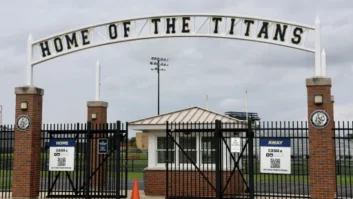
Peeking through the KALW ‘Hear Here’ exhibit. Photo by Jennifer Waits. When you travel to enough radio conferences, it’s a treat when one happens to take place in your own city, so I was happy to hop on BART this past May to attend the 38th annual National Federation of Community Broadcasters conference in San Francisco.
A range of community, public and college radio staff and practitioners travelled from all over the United States for the event. On the first day alone, I met people from as far away as Maine, Alaska and Guam, and ran into friends from all over California. Some were from tiny community-oriented stations, others were from major public radio affiliates, and some hailed from online-only stations with big FM dreams.
During her opening remarks, NFCB Vice President Ginny Berson surprised many of us when she announced her pending retirement from the organization. “Community radio faces some huge challenges,” she said, following with praise for the passionate people who are keeping community radio alive. “In spite of the difficulties, so many of you find a way out of ‘no way.’”
This theme of perseverance against all odds was present throughout the conference. Despite the paucity of economic resources and the ever-changing politics inherent in non-profit organizations that rely mostly on volunteer labor, non-commercial radio can also be a locus for creative and, some might even say, revolutionary programming.
This year’s conference used “transformation” as its overarching theme, and numerous presentations touched on that topic. During the lunchtime panel titled “What is the Future of Community Media and How Do We Get There?,” Sue Schardt from the Association of Independents in Radio said, “Transformation is not linear … Change comes from the outside.”
A few blocks from the conference site, at the San Francisco Museum of Modern Art (SFMOMA), the Kitchen Sisters, who produce the “Hidden Kitchens” radio series for NPR, spearheaded a live art event in conjunction with their new series “The Making Of…” Produced with KQED(FM) and AIR, the series is a community story project that features local artisans talking about their work (including such pieces as a submerged turntable, a karaoke ice cream truck and mushroom furniture).
During NFCB’s opening reception hosted by San Francisco community/public radio station KALW(FM), the intersections between radio, community storytelling and public art were on display. As attendees approached the room that housed the reception, they were invited to walk through KALW’s “Hear Here” exhibit, which showcased recorded stories from people in different neighborhoods in San Francisco and Oakland. The large, tunnel-like pieces (HEAR and HERE) had been crafted with cardboard.
Covered with local maps and punctuated with descriptions of stories captured in different neighborhoods in San Francisco and Oakland, the interactive display invited visitors to listen in using smartphones. Audio snippets were accessible through QR codes interspersed throughout the installation.
Using the technology and resources from KALW, conference-goers were asked to use their mobile phones to record bits and pieces of the conference in 30-second chunks. After uploading these clips to SoundCloud, a resulting “collaborative soundscape” was produced and played at the end of the conference. The final piece, edited by KALW producers Julie Caine and Chris Hoff, captured the flavor of the conference, including presentation snippets, interviews and call-sign shout-outs. These included some interesting sound bites, including a recording of a toilet flushing, applause, laughter and a guy doing a duck call.
The multifaceted role of sound was also the focus for the “Recipe for Good Listening” workshop. Featuring a number of radio producers, the in-depth, four-hour session was an interactive discussion about what qualifies as “good radio.” Panelist (and Kitchen Sister) Nikki Silva said that for her “Hidden Kitchens” series, music and sound are vital elements that help to advance the narrative. “We always feel like we’re making movies,” she said, explaining that the layers of sound are equivalent to pictures.
We also discussed the use of natural, ambient sounds vs. sound effects (KALW producer Martina Castro said that she will use one or the other, but never both within the same piece) and whether it was appropriate to use manufactured sound effects for a news story or a documentary feature (many journalists frown on this practice).
Anyone can create a mix of music, but WFMU(FM)’s Ken Freedman believes in the “artful segue” which, he said, is “the backbone of a great music show.” Freedman explained that it’s important to have a reason for why one song follows another, whether it’s vocal similarity, theme or a sonic connection (for example, follow a song that ends with the sound of strings with a song that begins with a similar sounding instrument).
Above all, one of my favorite panels was “Leveraging Social Media for News Engagement.” Applicable not only to radio stations, the tips provided by Kelly Chen and Meghann Farnsworth from the Center for Investigative Reporting were useful for anyone who uses Twitter, Facebook and other social media — for any reason. According to Chen and Farnsworth, Twitter can be used not only for breaking news (even collecting overheard public conversations on a particular topic of interest), but also to share snippets of stories that one is working on.
Finished pieces can be promoted in bite-sized chunks, highlighting weird facts or nuggets that might get overlooked. But be careful of auto-generated content, since tweets are are less likely to be read if it looks like they weren’t written by a person. Additionally, the panel suggested generating creative hashtags in order to build community. But however they do it, the radio participants at this conference made me fully aware that the best part of community radio is still the “community.”
Jennifer Waits wrote in June about the “What Is Radio” conference.







